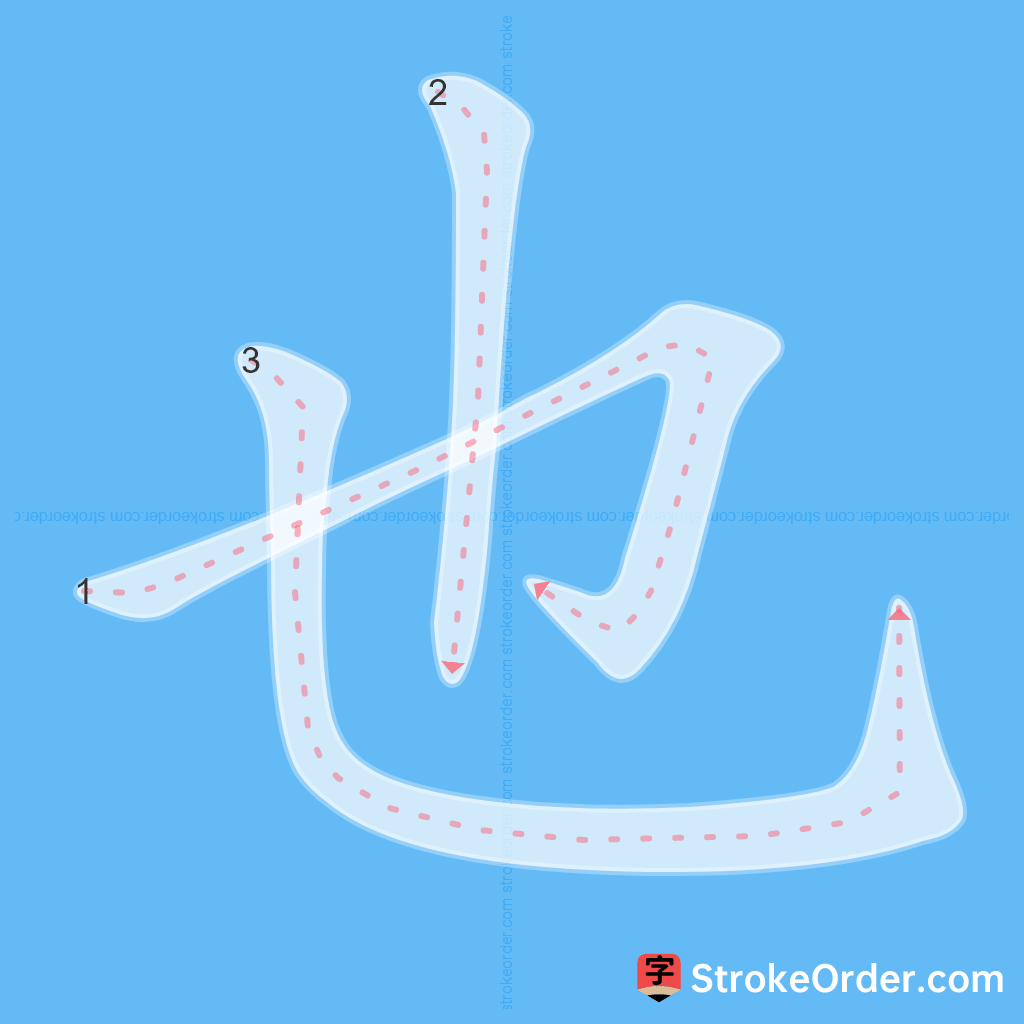也 Stroke Order
Animated Stroke Order of 也

Stroke Order Diagrams for 也

Step-by-Step Handwriting Guide for 也

Learn to Write Chinese Characters with Video Tutorials
Watch the video of writing the Chinese character "也", learn the correct stroke order (笔顺) of the character "也", and master the standard way of writing the character "也".
Free Printable Handwriting Practice with Stroke Order: 也
Printable Writing Practice Worksheet of "也" in Portrait Orientation (Tian Zi Ge)

Printable Writing Practice Worksheet of "也" in Landscape Orientation (Tian Zi Ge)

Information of 也
Pinyin
yě
Radical
乙
Strokes
3 strokes
Usage
★★★★★
Definition
also / too
也 [yě]
1. Adverb, indicating the meaning of "the same" or "parallel":
- You go, I also go. (你去,我~去。)
2. In negative sentences, it strengthens the tone:
- Not at all bad either. (一点儿~不错。)
3. In complex sentences, it indicates a turn or concession:
- Even if you don't say it, I can guess it pretty well. (虽然你不说,我~能猜个八九不离十。)
4. Classical Chinese mood particle (❶ indicates judgment; ❷ indicates question; ❸ indicates pause; ❹ adjective suffix).
5. Indicates tolerance or acknowledgment of a certain situation:
- Alright then. (~罢。)
Also:
1. Also indicates the same ([En.] also; too; as well; either).
Example:
- For example: I am happy, you are also happy; it can also be; it is also.
2. Repeated use emphasizes the parallelism or equality of two matters ([En.] as well as).
Example:
- For example: She can play basketball, and she can also play tennis.
3. Indicates a turn or concession ([En.] even).
Example:
- For example: Even if he fails ten times, he does not lose heart.
4. Indicates politeness.
Example:
- For example: I also have no choice but to do this.
5. Indicates emphasis ([En.] even).
Example:
- For example: One must also (one should also); even old people work.
6. Indicates choice, "or" ([En.] or).
Quote:
1. "Water Margin": You see how old that doorkeeper in my house is? Is he black and thin or white and stout?
Example:
- For example: It is also (or is it).
7. Used at the end of a sentence to indicate judgment or assertive mood, equivalent to "ah" or "yeah".
Quote:
1. Qing Dynasty – Yuan Mei "On Borrowing Books": The years of youth are to be regretted, ah.
2. Qing Dynasty – Xu Ke "Various Records of the Qing Dynasty": Then a white chieftain was seen… he is also an English officer.
8. Used in the middle of a sentence to indicate a pause.
Quote:
1. Qing Dynasty – Yuan Mei "On Borrowing Books": Knowing fortune and misfortune, then his reading must be focused.
9. Used at the end of a sentence to indicate a question, equivalent to "ne" or "ma".
Quote:
1. "Records of the Grand Historian": If it is for renting and farming, how can you be rich and noble?
10. Used at the end of the first half of the sentence, indicating a pause, softening the tone; the second half will explain the first half, emphasizing it.
Quote:
1. "Mencius": Therefore, this man must first suffer hardship in his heart and mind…
as empty as anything (idiom); completely bereft / to have nothing / vacuous / hollow / empty (argument, head etc)
lit. 之[zhi1], 乎[hu1], 者[zhe3] and 也[ye3] (four grammatical particles of Classical Chinese) (idiom); fig. archaic expressions
Input Method for 也
Pinyin
ye3
Wubi
bnhn
Cangjie
pd
Zhengma
yi
Four Corner
44712
Unicode
U+4e5f
Same Pronunciation Characters